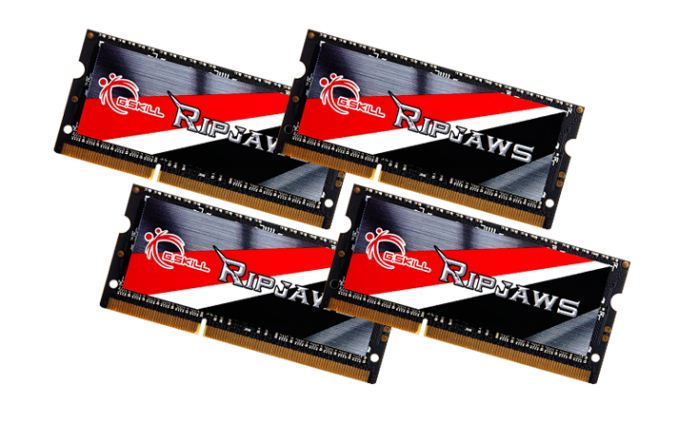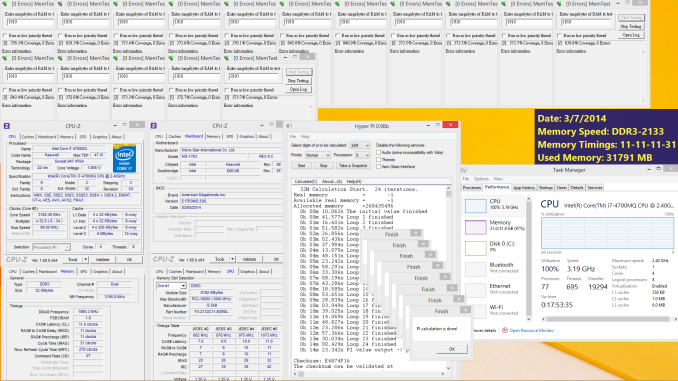G.Skill Launches 32GB DDR3L-2133 1.35V SO-DIMM Memory Kit
by Ian Cutress on April 22, 2014 5:03 AM EST
The topic of SO-DIMM memory is an interesting one. As it currently stands, almost all laptops with interchangeable memory slots have SO-DIMM slots, as well as a few motherboards at the low end and systems such as the ASRock M8. The main issue with SO-DIMM is that it is often limited in frequency – manufacturers who equip their laptops/motherboards with SO-DIMM slots typically do not worry about XMP, and as such SO-DIMM rarely sees more than 1600 MHz at a CAS latency of 11. However in recent quarters a couple of the memory manufacturers are bucking the trend, announcing that they have DDR3L memory in the smaller form factor that can support higher speeds. The newest release to this segment is G.Skill’s attempt to provide some of the fastest and dense modules available.
This week G.Skill is releasing a 4x8GB SO-DIMM kit, under their Ripjaws branding, capable of 2133 MHz at CL11 (while remaining within the 1.35V specification of DDR3L). The aim for this kit is mostly in the high end gaming laptops that support XMP, such as MSI’s GT70 range.
The combination of having four free SO-DIMM slots, and an XMP enabled laptop, puts this memory kit into those extreme niche markets. The ultimate irony here is that during our memory scaling articles, such as this one for Haswell CPUs, the biggest increase achieved with faster memory was with integrated graphics. Laptops at this price range that can equip this memory kit tend to rely on discrete graphics modules, and thus the faster memory (and high density) might be more appealing to workstation laptop type environments or those that pursue compute tasks. In our memory scaling testing, we saw an ideal medium around 2133 MHz CL9 memory, however anything that puts a laptop above 1600MHz CL11 is more than welcome in my view.
G.Skill is not stating an MSRP, however it should be roughly double the price of the two module kit version, making the 32GB kit around $360.
As we have mentioned in previous articles, buying all the modules you need in a single kit ensures they will work with each other. Buying two identical kits (e.g. two 2x8 kits) does not guarantee compatibility due to the strain on some memory controllers with the tighter secondary and tertiary sub-timings on kits with fewer modules.











12 Comments
View All Comments
blackmagnum - Tuesday, April 22, 2014 - link
I haven't met any problems using non-matching memory modules on any PCs or Macs. I believe it's an old wives' tale produced by the niche memory brand gang.Ian Cutress - Tuesday, April 22, 2014 - link
If you have a CPU with a strong IMC, you won't see an issue. But individual anecdotal evidence rarely hits the big picture. There are plenty of posts on forums where this is the exact issue because people buy two/four separate cheaper kits and assume they will just work. These smaller kits can have tighter timings for secondaries and tertiaries because it assumes it is the only kit in the PC, and these timings are loosened for larger kits. Sometimes the IMC doesn't have the headroom, sometimes the memory itself has no room to move. It's no old wives' tale, I can assure you. 16GB and higher, depending upon how capacitive the IC used is and the binning of the kit, you ideally want to purchase a single kit rated on the platform otherwise you can be in for a rough ride with manual settings and sometimes have to run a lower speed than the kits are rated for individually.yhselp - Wednesday, April 23, 2014 - link
What does this mean then; that system memory is essentially non-upgradable, what's the point of modular computers then? In my experience, the most common case with memory is that you buy less (or a 'standard' amount, e.g. 8GB now) initially with the option of doubling capacity (if you need) after a year or so.Obviously, there are problems - that's undeniable. The question is what can the end user do, apart from buying more initially or swapping the whole kit later on and effectively having to sell the old one.
Is it safe to assume that if you buy a mid/high-end kit from a popular brand and later on buy the same kit with the same timings from the same brand, they would work together? Also, assuming a high-end CPU.
Notmyusualid - Tuesday, April 22, 2014 - link
I had TONS of trouble getting 2x8GB kits to work on my M18x R2.Left to it's own devices, it read the SPD, and booted at 1600MHz, CAS9.
It refused to boot at 1866MHz, CAS10.
I tried all manner of settings.
In the end, I had to put in one module at a time and then it would only boot at 1866MHz CAS10, by setting it manually. Then I had two working. Three or four was blue screen.
I had to program the XMP profiles myself, as they were empty. A search of the web shows that many modules shipped as such. They never boot if bios is reset. You have to put a slow module in to force it to run at the worst timings for the slowest module.
Once you set this, you can select XMP1, and boot 1866MHz CAS10.
After much headache, I have 1866MHz, CAS9, Winsat mem is 2500GB/s+. 1.55v
I would love to see the results of Winsat Mem from your command line on these new modules...
Flunk - Tuesday, April 22, 2014 - link
I had a lot of problems with memory compatibility before. For example I have a Gigabye GA-Z68X-UD3H. I couldn't even get all memory I tried to boot at the rated frequency (I tried several options) and mixing brands resulted in failure to post at anything over 1333Mhz. I took the same hardware and replaced the board with a ASUS P8Z68-V Pro and everything worked without any issues, even RAM rated to 1866Mhz CL9 @ 1.5V (which Sandy Bridge chips are not supposed to support).Even with the IMC, the board still matters too. Some of them are really picky. Please note, this is exactly the same i5-2500K I was using.
Notmyusualid - Wednesday, April 23, 2014 - link
I too have had much memory issues with that same Z68 Gigabyte board, also running a 2500K. I bought 4GB of top-end Corsair memory at the time, and when trying to run XMP profiles, it would blue screen.So for the longest time I left it at the 1333MHz it would reliably run at. (client system, not mine)
But last week it was bothering me that a system should be left like that, and so I bought Gskill Trident 2400MHz CAS10 2x4GB sticks. NOW the system is running much better. Doesn't run at 2400 though, 2133 only. But I've not had any spare time to tinker with it yet...
How did you fare with the mSATA acceleration? It didn't work so well on that platform, so again last week a Kingston 3K 120GB disk went in as a boot disk, and the Intel 19GB SLC accelerator disk now functions perfectly in my M18x R2, as the accelerator for my 1TB storage... lucky me.
Impulses - Tuesday, April 22, 2014 - link
Memory compatibility issues are a funny thing, I've never had any issues myself either (tho I went thru a string of defective Ballistix back in the day) but I've seen plenty of it in the field... Mostly with older systems (lots of XP & P4 era Dells) or even recent but budget systems (ASUS netbook most recently). Several cases where memory that's completely in spec should work but doesn't, sometimes I've figured it out (double sided DIMM wouldn't work) and other times it's more obscure and I give up.Khenglish - Tuesday, April 22, 2014 - link
Ian from my testing it seems that this memory only works well in Haswell systems. Despite IVB systems running a higher voltage, they cannot hit the same clocks with this memory as the Haswell IMC can. Could you test this out to confirm whether or not IVB and SB laptop users can buy this ram and run it at the rated speed?Notmyusualid - Wednesday, April 23, 2014 - link
+1, and show us the command line result of : winsat mem.Thanks.
Hrel - Thursday, April 24, 2014 - link
"The newest release to this segment is G.Skill’s attempt to provide some of the fastest and dense modules available." - some of the fastest and most* dense modules available.